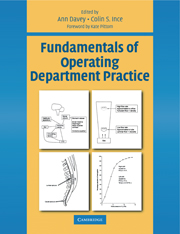Book contents
- Frontmatter
- Contents
- Contributors
- Preface
- Foreword
- Acknowledgements
- Introduction
- Chapter 1 The operating department practitioner, the patient and the law
- Chapter 2 Aspects of health and safety in the operating department
- Chapter 3 The caring practitioner
- Chapter 4 Strategies for infection control in the operating department
- Chapter 5 Sterilization, decontamination and the surgical field
- Chapter 6 The fundamentals of cardiovascular physiology
- Chapter 7 Fundamentals of respiratory physiology
- Chapter 8 Scientific principles in relation to the anaesthetic machine
- Chapter 9 Fundamentals of artificial ventilation of the lung
- Chapter 10 Scientific principles in relation to monitoring equipment
- Chapter 11 Scientific principles in relation to endoscopic, laser and radiological equipment
- Chapter 12 Pharmacological principles of drug administration
- Chapter 13 The pharmacology of drugs used in general anaesthesia
- Chapter 14 The local anaesthetic drugs - does the ideal agent exist?
- Chapter 15 The safe positioning of patients for surgery
- Chapter 16 Principles involved in the management and use of equipment
- Chapter 17 Understanding suture materials
- Chapter 18 Fundamentals ofpaediatric surgery and anaesthesia
- Chapter 19 Fundamentals of hyperthermia and hypothermia
- Chapter 20 Fundamentals of fluid and electrolyte balance during surgery
- Chapter 21 The physiology of blood and its administration
- Chapter 22 Fundamentals of pain relief
- Chapter 23 Fundamentals of dressings and drains in relation to wound healing
- Chapter 24 The recovery of patients from anaesthesia and surgery
- Chapter 25 Fundamentals of emergency and obstetric anaesthesia
- Chapter 26 Identification and management of anaesthetic emergencies
- Chapter 27 The fundamentals of emergency resuscitation
- Appendixes
- Index
Chapter 16 - Principles involved in the management and use of equipment
Published online by Cambridge University Press: 05 October 2015
- Frontmatter
- Contents
- Contributors
- Preface
- Foreword
- Acknowledgements
- Introduction
- Chapter 1 The operating department practitioner, the patient and the law
- Chapter 2 Aspects of health and safety in the operating department
- Chapter 3 The caring practitioner
- Chapter 4 Strategies for infection control in the operating department
- Chapter 5 Sterilization, decontamination and the surgical field
- Chapter 6 The fundamentals of cardiovascular physiology
- Chapter 7 Fundamentals of respiratory physiology
- Chapter 8 Scientific principles in relation to the anaesthetic machine
- Chapter 9 Fundamentals of artificial ventilation of the lung
- Chapter 10 Scientific principles in relation to monitoring equipment
- Chapter 11 Scientific principles in relation to endoscopic, laser and radiological equipment
- Chapter 12 Pharmacological principles of drug administration
- Chapter 13 The pharmacology of drugs used in general anaesthesia
- Chapter 14 The local anaesthetic drugs - does the ideal agent exist?
- Chapter 15 The safe positioning of patients for surgery
- Chapter 16 Principles involved in the management and use of equipment
- Chapter 17 Understanding suture materials
- Chapter 18 Fundamentals ofpaediatric surgery and anaesthesia
- Chapter 19 Fundamentals of hyperthermia and hypothermia
- Chapter 20 Fundamentals of fluid and electrolyte balance during surgery
- Chapter 21 The physiology of blood and its administration
- Chapter 22 Fundamentals of pain relief
- Chapter 23 Fundamentals of dressings and drains in relation to wound healing
- Chapter 24 The recovery of patients from anaesthesia and surgery
- Chapter 25 Fundamentals of emergency and obstetric anaesthesia
- Chapter 26 Identification and management of anaesthetic emergencies
- Chapter 27 The fundamentals of emergency resuscitation
- Appendixes
- Index
Summary
INTRODUCTION
The management of equipment in the operating department is a demanding task that should involve both the medical and non-medical members of the theatre team. If operating theatres are to be run in a safe and efficient manner, management structures must include the policies and protocols needed for the dayto- day management of equipment as well as long-term strategies.
Equipment is constantly introduced into hospitals for a variety of reasons, such as new equipment replacing that which is old and worn out, the development of new technology and, of course, the new devices that improve our working lives. Manufacturing companies may promote them as being more user friendly, time saving, cost efficient or safer but the theatre user must become familiar with all equipment and learn how to use it safely and wisely.
The introduction of equipment to a hospital is a complicated process and involves many different groups of people, i.e. the manufacturers, engineers, servicing departments, repair specialists, departments within the hospital and the individual user.
MANAGING THE USE OF EQUIPMENT
WHAT IS MEDICAL EQUIPMENT?
Medical equipment is equipment intended to diagnose, treat or monitor the patient under medical supervision and which makes physical contact with the patient or conveys energy to or receives energy from the patient. The type of protection that equipment provides against electric shock is classified as follows:
• Class 1 equipment relies on protective earthing mechanisms.
• Class 2 equipment relies on sturdy insulation.
• Internally powered equipment is classified separately.
DESIGN OF MEDICAL EQUIPMENT AND THE MANAGEMENT OF RISK
Medical equipment must not only be safe to use but also inherently safe. Although this chapter primarily deals with the management and use of equipment, it is important to have a basic understanding of how medical equipment has evolved in terms of safety. When anaesthetic machines were first introduced, it was not possible to accurately control the concentration of anaesthetic vapour that the patient received and even today many anaesthetic machines are incapable of preventing the delivery of a hypoxic mixture of gases to the patient.
Information
- Type
- Chapter
- Information
- Fundamentals of Operating Department Practice , pp. 177 - 186Publisher: Cambridge University PressPrint publication year: 1999
